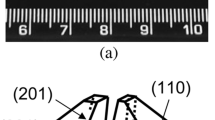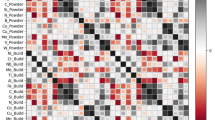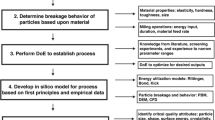Abstract
Computational modeling, machine learning, and statistical data analysis are increasingly utilized to mitigate chemistry, manufacturing, and control failures related to particle properties in solid dosage form manufacture. Advances in particle characterization techniques and computational approaches provide unprecedented opportunities to explore relationships between particle morphology and drug product manufacturability. Achieving this, however, has numerous challenges such as producing and appropriately curating robust particle size and shape data. Addressing these challenges requires a harmonized strategy from material sampling practices, characterization technique selection, and data curation to provide data sets which are informative on material properties. Herein, common sources of error in particle characterization and data compression are reviewed, and a proposal for providing robust particle morphology (size and shape) data to support modeling efforts, approaches for data curation, and the outlook for modeling particle properties are discussed.





Similar content being viewed by others
References
Sacks LV, Shamsuddin HH, Yasinskaya YI, Bouri K, Lanthier ML, et al. Scientific and Regulatory reasons for delay and denial of FDA approval of initial applications for new drugs, 2000–2012. JAMA. 2014;311(4):378–84.
Chattoraj S, Daugherity P, McDermott T, Olsofsky A, Roth W, Tobyn M. Sticking and picking in pharmaceutical tablet compression: an IQ consortium review. J Pharm Sci. 2018;107(9):2267–82.
Leane M, Pitt K, Reynolds G. Mfg classification syst MCSW. A proposal for a drug product manufacturing classification system (MCS) for oral solid dosage forms. Pharm Dev Technol. 2015;20(1):12–21.
Leane M, Pitt K, Reynolds GK, Dawson N, Ziegler I, Szepes A, et al. Manufacturing classification system in the real world: factors influencing manufacturing process choices for filed commercial oral solid dosage formulations, case studies from industry and considerations for continuous processing. Pharm Dev Technol. 2018;10:964–77.
Mamidi HK, Mishra SM, Rohera BD. Application of modified SeDeM expert diagram system for selection of direct compression excipient for liquisolid formulation of Neusilin US2. Journal of Drug Delivery Science and Technology. 2021;64:1–11.
Scholz JC, Steenekamp JH, Hamman JH, Tiedt LR. The SeDeM Expert Diagram System: Its performance and predictability in direct compressible formulations containing novel excipients and different types of active ingredients. Powder Technol. 2017;312:222–36.
Gabas N, Hiquily N, Laguerie C. Response of laser diffraction particle sizer to anisometric particles. Part Part Syst Charact. 1994;11:121–6.
Kippax P. Appraisal of the laser diffraction particle-sizing technique. Pharmaceutical Technology. 2005:88 - 96.
Zaidi K. USP <429>. United States Pharmacopeia. 2016;35(3).
Ferreira AP, Gamble JF, Leane MM, Park H, Olusanmi D, Tobyn M. Enhanced understanding of pharmaceutical materials through advanced characterization and analysis. AAPS PharmSciTech. 2018;19(8):3462–80.
Gamble JF, Tobyn M, Hamey R. Application of image-based particle size and shape characterization systems in the development of small molecule pharmaceuticals. J Pharm Sci. 2015;104(5):1563–74.
Goh HP, Heng, P.W.S., Liew, C.V. Comparative evaluation of powder flow parameters with reference to particle size and shape. International Journal of Pharmaceutics. 2018(547):133–41.
Jaklic M, Kocevar K, Srcic S, Dreu R. Particle size-based segregation of pharmaceutical powders in a vertical chute with a closed bottom: an experimental evaluation. Powder Technol. 2015;278:171–80.
Munoz SC, Yu W, Pantelides CC. SimCU: A new model to assess content uniformity or oral dosages based on particulate mass balances and Monte Carlo simulations. Chem Eng Res Des. 2016;109:532–9.
Pepin XJH, Flanagan TR, Holt DJ, Eidelman A, Treacy D. Justification of drug product dissolution rate and drug substance particle size specifications based on absorption PBPK modeling for lesinurad immediate release tablets. Mol Pharm. 2016;13:3256–69.
Adi H, Larson I, Stewart P. Laser diffraction particle sizing of cohesive lactose powders. Powder Technol. 2007;179:90–4.
Hatcher LE, Li, Wei., Payne, P., Benyahia, B., Rielly, C.D., Wilson, C.C. Tuning Morphology in active pharmaceutical ingredients: controlling the crystal habit of lovastatin through solvent choice and non-size-matched polymer Additives. Cryst Growth Des 2020;20:5854 - 62
Amidon GE, Secreast, P.J., Mudie, D. Particle, powder, and compact characterization. developing solid oral dosage forms: pharmaceutical theory and practice. Elsevier Inc.; 2009. p. 163 - 86.
Brittain HG. Characterization of pharmaceutical compounds in the solid state. Sep Sci Technol. 2011;10:11–58.
Gamble JF, Tobyn M, Hamey R. Application of image-based particle size and shape characterization systems in the development of small molecule pharmaceuticals. J Pharm Sci. 2015;104:1563–74.
Gy P. Sampling of discrete materials - a new introduction to the theory of sampling I. Qualitative approach. Chemometrics and Intelligent Laboratory Systems. 2004;74:7 - 24.
Gy P. Sampling of discrete materials II. Quantitative approach - sampling of zero-dimensional objects. Chemometrics and Intelligent Laboratory Systems. 2004;74:25 - 38.
Gy P. Sampling of discrete materials. Chemom Intell Lab Syst. 2004;74:39–47.
ISO 13320:2020(en) Particle size analysis - laser diffraction methods. 2020.
Zaidi KM, K. Light Diffraction Measurement of Particle Size. United States Pharmacopeia. 2016;35(3).
Tinke AP, Carnicer, A., Govoreanu, R., Scheltjens, G., Lauwerysen, L., Mertens, N. et al. Particle shape and orientation in laser diffraction and static image analysis size distribution analysis of micrometer sized rectangular particles. Powder Technology. 2008;186(2008):154 - 67. https://doi.org/10.1016/j.powtec.2007.11.017.
Tinke AP, Vanhoutte K, Vanhoutte F, De Smet M, De Winter H. Laser diffraction and image analysis as a supportive analytical tool in the pharmaceutical development of immediate release direct compression formulations. Int J Pharm. 2005;297(1–2):80–8.
Kelly RN, DiSante, K.J., Stranzl, E., Kazanjian, J.A., Bowen, P., Matsuyama, T. et al. Graphical comparison of image analysis and laser diffraction particle size analysis data obtained from the measurements of nonspherical particle systems. AAPS PharmSciTech. 2006;7(3).
Font-Munoz JSJ, R., Tuval, I., and Basterretxea, G. Method for the determination of preferential orientation of marine particles from laser diffraction measurements. Optics Express. 2020;28(9). https://doi.org/10.1364/OE.390388.
Matsuyama T, Yamamoto H. Particle shape and laser diffraction: a discussion of the particle shape problem. J Dispersion Sci Technol. 2008;24(4):409–16.
ISO 13322–2: 2021, Particle size analysis - Image analysis methods - Part 2: Dynamic image analysis methods. 2021.
Brown L: Depth of field considerations in dynamic imaging particle analysis. (2014). Accessed.
Gamble JF, Ferreira AP, Tobyn M, DiMemmo L, Martin K, Mathias N, et al. Application of image based tools for the characterisation of hollow spray dried amorphous dispersion particles. Int J Pharm. 2014;465(1–2):210–7.
Gamble JF, Dawson N, Murphy D, Theophilis A, Kippax P. A proposal for an alternative approach to particle size method development during early-stage small molecule pharmaceutical development. J Pharm Sci. 2019;108:3515–20. https://doi.org/10.1016/j.xphs.2019.08.007.
Press G. Cleaning big data: most time-consuming, least enjoyable data science task, Servey Says. Forbes2016.
McKinney W. Data structures for statistical computing in python. Proceedings of the 9th Python in Science Conference, Austin, TX. 2010.
Pedregosa F, Varoquaux G, Gramfort A, Michel V, Thirion B, et al. Scikit-learn: Machine learning in python. The Journal of Machine Learning Research. 2011;12:2825–30.
Mullarney MP, Leyva N. Modelling pharmaceutical powder flow performance using particle size distribution data. Pharm Technol. 2009;33(3):126–34.
McInnes L, Healy J, Melville J. Umap: uniform manifold approximation and projection for dimension reduction. arXiv e-prints. 2018.
Barjat H, Checkley S, Chitu T, Dawson N, Farschi A, Ferreira A, et al. Demonstration of the feasibility of predicting the flow of pharmaceutically relevant powders from particle and bulk physical properties. J Pharm Innov. 2021;16:181–96.
Valente R, Ostapenko A, Sousa C, Grubbs J, Massar CJ, Cote DL, et al. Classifying powder flowability for cold spray additive manufacturing using machine learning. In: IEEE International Conference on Big Data. Atlanta: IEEE; 2020. p. 2919–28.
Acknowledgements
The authors would like to thank Srini Sridharan and Tracy Gaebele for their guidance and support during the authorship of this manuscript.
Author information
Authors and Affiliations
Contributions
All authors contributed to the study conception and design. Material preparation, data collection, and analysis were performed by John Gamble, Yue Schuman, Lauren Taylor, and Robert C. Wadams. The first draft of the manuscript was written by Robert C. Wadams and all authors commented on previous versions of the manuscript. All authors read and approved the final manuscript.
Corresponding author
Ethics declarations
Conflict of Interest
The authors declare no competing interests.
Additional information
Publisher’s Note
Springer Nature remains neutral with regard to jurisdictional claims in published maps and institutional affiliations.
Rights and permissions
About this article
Cite this article
Wadams, R.C., Akseli, I., Albrecht, J. et al. Particle Property Characterization and Data Curation for Effective Powder Property Modeling in the Pharmaceutical Industry. AAPS PharmSciTech 23, 286 (2022). https://doi.org/10.1208/s12249-022-02434-2
Received:
Accepted:
Published:
DOI: https://doi.org/10.1208/s12249-022-02434-2




